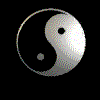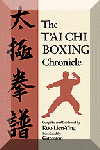


Also a
Spanish edition
The
Guang P'ing
T’ai Chi Page

Theories 2 - The Form
The form is the first step in learning T'ai Chi Ch'uan. To execute the form, posture is the essential point. If the posture is incorrect, then the idea of balance has been ignored. Then, the movements will not have the power of T’ai Chi Ch’uan. From the very first attempt to learn this art, this area must be fully mastered and from the beginning the effort to create correct posture of the body must be made. The T'ai Chi Boxing Chronicle says, “The body is like a scale. It is an ancient dictum that the top of the head should be held as though suspended from above. The hands are the plates that balance the right and left. The waist must be level like the base of a tree with its roots above the ground. Stand like a scale so that the light and heavy or rising and falling can be measured to the smallest degree. Any leaning is a defect. The top of the head is suspended with the waist as the root. There must be a straight line between the top of the head, the spine, and the middle of the waist. This is what allows one to turn and revolve. The body measures like a scale and revolves. The intention commands the Ch’i like a flag, naturally. Make the body light and sharp so it can become the perfect body. This way the coming and going or entering and retreating will not be early or late”.
Now that the first theorem has been presented, what does it mean? It means that if you want to have the correct posture of T'ai Chi Ch'uan, certain rules must be followed from the very outset. It means that in every movement, there must be a straight line between the middle of the top of the head through the neck, through the spine to the sacrum (tailbone). The tailbone cannot be allowed to protrude outward but has to always be tucked in to conclude this straight line. This practice will prevent a swayback that reduces the power of the twisting waist and spine.


Usually a photograph tells a lot about the practitioner. What do the T’ai Chi classics say in regard to posture? They say that any leaning is a defect. They say that the head must be as suspended from above. They say there must be a straight line from the top of the head to the end of the spine. Look at photographs of those who call themselves “masters” and judge for your self. Did they get the point, or miss it? The classics are our guidepost as a grammar book leads to the correct use of language. This is the beginning of the T’ai Chi boxing learning process so it is crucial to get the point right from the beginning! This will prevent lost years of practice and regret. The boxing chronicles say “the body must be centered and comfortable". It must be able to handle impact from any direction. The center of the waist and the top of the head must be in a straight line as though a line was drawn between them. To be centered is paramount. If one leans forward, the back cannot respond. If the body slants to the left or right, one side of the body will not be able to respond”. Mr. Kuo Lien Ying practiced according to the theories and principles of the T’ai Chi boxing art. His posture is immaculate and should be used as an example. This is the T’ai Chi Body 身
To further explore the T’ai Chi body one must study
the Form ![]() the
the
Spine![]() , and the
Steps
, and the
Steps ![]() .
.
The form according to the boxing chronicles should be
like a hawk seizing a rabbit. It
means that the body is aroused and can revolve without hindrance.
It also says, “when the force of the Ch’i ![]() is transferred, the
spirit of vitality is concentrated, and when the wheel is pulled it can
revolve unhindered. If the spirit
of vitality cannot be aroused, then the form appears dull”.
This means that the Ch’i
which is the
circulating point of energy that circulates from the bottom of the foot up
through legs, waist, spine, and out to the arms and hands and then down again
then it can manifest on the outside. Then
the wheel and axle can revolve to suit the circumstances.
is transferred, the
spirit of vitality is concentrated, and when the wheel is pulled it can
revolve unhindered. If the spirit
of vitality cannot be aroused, then the form appears dull”.
This means that the Ch’i
which is the
circulating point of energy that circulates from the bottom of the foot up
through legs, waist, spine, and out to the arms and hands and then down again
then it can manifest on the outside. Then
the wheel and axle can revolve to suit the circumstances.
In
this alignment, the study of the waist must be considered.
“If the waist is not centered or if the axle is bent, the body cannot
revolve”. The waist must be
parallel to the ground at all times, not tilted at all.
The spine sits straight on the waist as in the following diagram:

If the wheel and axle on the right revolves quickly,
the structure will be toppled because the spine is bent.
It is also easy to omit researching the Top of the
Head. Boxing classics say, “the
Ch’i sinks to the Tan T’ien ![]() . The Tan T’ien is the body’s center of gravity and in the
above illustrations would be the point where the spine meets the waist.
The Ch’i circulates to the top of the head as well as the arms.
If the top of the head is tilted, even slightly, this will impede the
turning of the waist and spine.
. The Tan T’ien is the body’s center of gravity and in the
above illustrations would be the point where the spine meets the waist.
The Ch’i circulates to the top of the head as well as the arms.
If the top of the head is tilted, even slightly, this will impede the
turning of the waist and spine.
The steps are the foundation of the waist and spine and must be given deep consideration. Footwork supports the actions of the waist and spine. If the body revolves then the steps follow to support the twisting motion of the waist and spine. However, when you enter or retreat then the body follows the steps. The body is not revolving in this case but it can revolve at any instant as circumstances dictate.